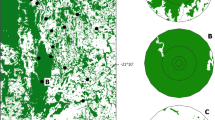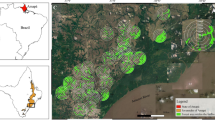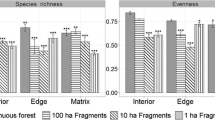Abstract
The conversion of natural areas into agricultural landscapes results in different mosaics of land use types, modifying biodiversity and consequently altering the patterns of ecological interactions, such as between frugivorous bats and ectoparasites. Our objectives were to investigate whether variations in the configuration and composition of human-disturbed landscapes interfere with the prevalence and average intensity of ectoparasite infestation in the frugivorous bats Artibeus lituratus (Olfers, 1818), Carollia perspicillata (Linnaeus, 1758), and Sturnira lilium (É Geoffroy, 1810), in a region of the Brazilian Atlantic Forest. We also evaluated whether there is a response in the parasite load associated with the ectoparasite group (mite or fly). We found six species of flies and three mites. The proportion of infested hosts was more affected by the landscape than the mean infestation values. Land cover diversity influenced seven of the interactions studied. Forest cover affected eight of the interactions and was associated with a reduction in the parasite load in seven of them. The increase in the proportion of edges per area of each fragment presented a different influence related to the host species. Variations in parasite load did not show any typical response related to the mite or fly group. Our study indicates that landscape configuration and composition interfere with bat-ectoparasite interactions, which may be related to interference in encounter rates between hosts (for mites and flies) and between hosts and their ectoparasites in roosts (for flies). The taxonomic identity of the interacting species suggests that the relationship with the landscape is context-dependent.


Similar content being viewed by others
Data availability
Data are available in the Supplementary Material.
References
Aguiar LMS, Bernard E, Machado RB (2014) Habitat use and movements of Glossophaga soricina and Lonchophylla dekeyseri (Chiroptera: Phyllostomidae) in a Neotropical savannah. Zool 31(3):223–229. https://doi.org/10.1590/S1984-46702014000300003
Barbier E, Graciolli G, Bernard E (2019) Structure and composition of Nycteribiidae and Streblidae flies on bats along an environmental gradient in northeastern Brazil. Can J Zool 97(5):409–418. https://doi.org/10.1139/cjz-2018-0098
Barbier E, Urbieta GL, Nunes H, Bomfim SS, Rocha PA (2019) High specificity and aggregation but low prevalence in bat-fly interactions in an environmental protection area in Brazil. Acta Chiropterol 21(2):443–452. https://doi.org/10.3161/15081109ACC2019.21.2.018
Bartoń K (2019) MuMIn: Multi‐model inference. R package version 1.43.6. http://cran.r-project.org/package=MuMIn. Accessed 12 May 2019
Bates D, Mächler M, Bolker BM, Walker SC (2015) Fitting linear mixed-effects models using lme4. J Stat Softw 67(1):1–48. https://doi.org/10.18637/jss.v067.i01
Bernard E, Fenton MB (2003) Bat mobility and roosts in a fragmented landscape in Central Amazonia. Brazil Biotropica 35(2):262–277. https://doi.org/10.1111/j.1744-7429.2003.tb00285.x
Bezerra RHS, Bocchiglieri A (2018) Association of ectoparasites (Diptera and Acari) on bats (Mammalia) in a restinga habitat in northeastern Brazil. Parasitol Res. https://doi.org/10.1007/s00436-018-6034-0
Bolívar-Cimé B, Cuxim-Koyoc A, Reyes-Novelo E, Morales-Malacara JB, Laborde J, Flores-Peredo R (2017) Habitat fragmentation and the prevalence of parasites (Diptera, Streblidae) on three phyllostomid bat species. Biotropica 50(1):1–8. https://doi.org/10.1111/btp.12489
Breviglieri CPB, Piccoli GCO, Uieda W, Romero GQ (2013) Predation-risk effects of predator identity on the foraging behaviors of frugivorous bats. Oecologia 173(3):905–912. https://doi.org/10.1007/s00442-013-2677-9
Burnham K, Anderson D (2002) Model selection and multimodel inference: a practical information-theoretic approach. Springer, New York
Cisneros LM, Fagan ME, Willig MR (2015) Effects of human-modified landscapes on taxonomic, functional and phylogenetic dimensions of bat biodiversity. Divers Distrib 21:523–533. https://doi.org/10.1111/ddi.12277
Díaz MM, Solari S, Aguirre LF, Aguiar LMS, Barquez RM (2016) Clave de identificación de los murciélagos de Sudamérica – Chave de identificação dos morcegos da América do Sul, Publicación Especial 2, PCMA (Programa de Conservación de los Murciélagos de Argentina), Tucumán
Dick CW, Patterson BD (2007) Against all odds: explaining high host specificity in dispersal-prone parasites. Int J Parasitol 37:871–876. https://doi.org/10.1016/j.ijpara.2007.02.004
Dittmar K, Dick CW, Patterson BD, Whiting MF, Gruwell ME (2009) Pupal deposition and ecology of bat flies (Diptera: Streblidae): Trichobius sp (Caecus group) in a Mexican cave habitat. J Parasitol 95(2):308–14
Estavillo C, Pardini R, Rocha PLB (2013) Forest loss and the biodiversity threshold: an evaluation considering species habitat requirements and the use of matrix habitats. PLoS ONE 8(12):1–10. https://doi.org/10.1371/journal.pone.0082369
Fabián ME, Rui AM, Waechter JL (2008) Plantas utilizadas como alimento por morcegos (Chiroptera, Phyllostomidae), no Brasil. Reis NR, Peracchi AL. Technical Books, Londrina, Santos GASD. Ecologia de Morcegos, pp 51–70
Fagundes R, Antonini Y, Aguiar LMS (2017) Overlap in cave usage and period of activity as factors structuring the interactions between bats and ectoparasites. Zool Stud 56(22):1–11. https://doi.org/10.6620/ZS.2017.56-22
Fahrig L, Baudry J, Brotons L, Burel FG, Crist TO, Fuller RJ, Sirami C, Siriwardena GM, Martin JL (2011) Functional landscape heterogeneity and animal biodiversity in agricultural landscapes. Ecol Lett 14(2):101–112. https://doi.org/10.1111/j.1461-0248.2010.01559.x
Fenton MB, Acharya L, Audet D, Hickey MBC, Merriman C, Obrist MK, Syme DM, Adkins B (1992) Phyllostomid bats (Chiroptera: Phyllostomidae) as indicators of habitat disruption in the neotropics. Biotropica 24(3):440–446
Fenton MB, Rautenbach IL, Smith SE, Swanepoel CM, Grosell J, van Jaarsveld J (1994) Raptors and bats: threats and opportunities. Anim Behav 48(1):9–18
Fischer J, Lindenmayer DB (2007) Landscape modification and habitat fragmentation: a synthesis. Glob Ecol Biogeogr 16:265–280. https://doi.org/10.1111/j.1466-8238.2007.00287.x
Gorresen PM, Willig MR (2004) Landscape responses of bats to habitat fragmentation in Atlantic Forest of Paraguay. J Mammal 85(4):688–697. https://doi.org/10.1644/BWG-125
Graciolli G, Carvalho CJB (2001) Moscas ectoparasitas (Diptera, Hippoboscoidea) de morcegos (Mammalis, Chiroptera) do estado do Paraná II Streblidae Chave pictórica para gêneros e espécies. Rev Bras Zool 18(3):907–60. https://doi.org/10.1590/S0101-81752001000300026
Graham SP, Hassan KH, Nathan DBC, Craig G, Thomas RU (2009) Nestedness of ectoparasite-vertebrate host networks. PLoS ONE 4(11):1–8. https://doi.org/10.1371/journal.pone.0007873
Guerrero R (1993) Catálogo de los Streblidae (Diptera: Pupipara) parásitos de murciélagos (Mammalia: Chiroptera) del nuevo mundo i clave para los géneros y nycterophiliin. Acta Biol Venezuelica 14(4):61
Guerrero R (1994a) Catálogo de los Streblidae (Diptera: Pupipara) parásitos de murciélagos Mammalia: Chiroptera del nuevo mundo ii los grupos: pallidus caectus major uniformis y longipes del género Trichobius Gervais, 1844”. Acta Biol Venezuelica 15(1):1–18
Guerrero R (1994b) Catálogo de los Streblidae (Diptera: Pupipara) parásitos de murciélagos (Mammalia: Chiroptera) del nuevo mundo iv Trichobiinae con alas desarrolladas. Bol Entomol Venezolana 9(2):161–92
Guerrero R (1995a) Catálogo de los Streblidae (Diptera: Pupipara) parásitos de murciélagos (Mammalia: Chiroptera) del nuevo mundo v Trichobiinae con alas reducidas o ausentes y misceláneos. Bol Entomol Venezolana 10(2):135–60
Guerrero R (1995b) Catálogo de los Streblidae (Diptera: Pupipara) parásitos de murciélagos (Mammalia: Chiroptera) del nuevo mundo iii los grupos: dugesii, dunni y phyllostomae del genero Trichobius Gervais, 1844. Acta Biol Venezuelica 15(3–4):1–27
Guerrero R (1996) Catálogo de los Streblidae (Diptera: Pupipara) parásitos de murciélagos (Mammalia: Chiroptera) del nuevo mundo vi Streblinae. Acta Biol Venezuelica 16(2):1–25
Hair JF, Black WC, Babin BJ, Anderson RE (2014) Multivariate data analysis: Pearson new international edition. Pearson Education Limited, Harlow
Hartig F (2019) DHARMa: residual diagnostics for hierarchical (Multi-Level/Mixed) regression models. R package version 0.2.6. https://cran.r-project.org/web/packages/DHARMa/index.html. Accessed 15 December 2019
Harvey CA, Komar O, Chazdon R, Ferguson BG, Finegan B, Griffith DM, Martínez-Ramos M, Morales H, Nigh R, Soto-Pinto L, Breugel MV, Wishnie M (2008) Integrating agricultural landscapes with biodiversity conservation in the Mesoamerican hotspot. Conserv Biol 22(1):8–15. https://doi.org/10.1111/j.1523-1739.2007.00863.x
Hernández-Martínez J, Morales-Malacara JB, Alvarez-Añorve MY, Amador-Hernández S, Oyama K, Avila-Cabadilla LD (2018) Drivers potentially influencing host – bat fly interactions in anthropogenic Neotropical landscapes at different spatial scales. Parasitol 146(1):74–88. https://doi.org/10.1017/S0031182018000732
Herrin CS, Tipton VJ (1975) Spinturnicid mites of Venezuela (Acarina: Spinturnicidae). Bricham Young Univ Sci Bull 20:1–72
Klingbeil BT, Willig MR (2009) Guild-specific responses of bats to landscape composition and configuration in fragmented Amazonian rainforest. J Appl Ecol 46(1):203–213. https://doi.org/10.1111/j.1365-2664.2008.01594.x
Klompen JSH (1992) Phylogenetic relationships in the mite family Sarcoptidae (Acari: Astigmata). Misc. Publ. Univ. Michigan. Mus Zool 180:1–155
Kunz TH, Torrez EB, Bauer D, Lobova T, Fleming TH (2011) Ecosystem services provided by bats. Ann N Y Acad Sci 1223(1):1–38. https://doi.org/10.1111/j.1749-6632.2011.06004.x
Laurindo RS, Vizentin-Bugoni J (2020) Diversity of fruits in Artibeus lituratus diet in urban and natural habitats in Brazil: a review. J Trop Ecol 36:65–71. https://doi.org/10.1017/S0266467419000373
Laurindo RS, Gregorin R, Tavares DC (2017) Effects of biotic and abiotic factors on the temporal dynamic of bat-fruit interactions. Acta Oecol 83:38–47. https://doi.org/10.1016/j.actao.2017.06.009
Laurindo RS, Novaes RLM, Vieira MCW (2014) RPPN Fazenda Lagoa: educação, pesquisa e conservação da natureza. ISMECN, Monte Belo
Loayza AP, Loiselle BA (2009) Composition and distribution of a bat assemblage during the dry season in a naturally fragmented landscape in Bolivia. J Mammal 90(3):732–742. https://doi.org/10.1644/08-MAMM-A-213R.1
López-Bao J, González-Varo JP (2011) Frugivory and spatial patterns of seed deposition by carnivorous mammals in anthropogenic landscapes: a multi-scale approach. PLoS ONE 6(1):19–21. https://doi.org/10.1371/journal.pone.0014569
Lourenço EC, Patrício PMP, Famadas KM (2016) Community components of spinturnicid mites (Acari: Mesostigmata) parasitizing bats (Chiroptera) in the Tinguá Biological Reserve of Atlantic Forest of Brazil. Int J Acarol. https://doi.org/10.1080/01647954.2015.1117525
McGarigal K, Marks BJ (1995) Fragstats: spatial pattern analysis program for quantifying landscape structure. Portland, Department of Agriculture, Forest Service, Pacific Northwest Research Station, General Technical Report PNW-GTR-351. https://doi.org/10.2737/PNW-GTR-351. Accessed 20 February 2019
McGarigal K, Cushman SA, Ene E (2012) Fragstats v4: spatial pattern analysis program for categorical and continuous maps. Computer Software Program Produced by the Authors at the University of Massachusetts, Amherst. http://www.umass.edu/landeco/research/fragstats/fragstats.html. Accessed 14 January 2019
Medina A, Harvey CA, Merlo DS, Vílchez S, Hernández B (2007) Bat diversity and movement in an agricultural landscape in Matiguás. Nicaragua Biotropica 39(1):120–128. https://doi.org/10.1111/j.1744-7429.2006.00240.x
Mello MAR, Schittini GM, Selig P, Bergallo HG (2004) Seasonal variation in the diet of the bat Carollia Perspicillata (Chiroptera: Phyllostomidae) in an Atlantic Forest area in southeastern Brazil. Mammalia 68(1):49–55. https://doi.org/10.1515/mamm.2004.006
Mello MAR, Kalko EKV, Silva WR (2008) Diet and abundance of the bat Sturnira lilium (Chiroptera) in a Brazilian montane Atlantic Forest. J Mammal 89(2):485–492. https://doi.org/10.1644/06-MAMM-A-411R.1
Mello RM, Nobre PH, Manhães MA, Pereira LC (2014) Frugivory by Phyllostomidae bats in a montane Atlantic Forest, southeastern Minas Gerais, Brazil. Ecotropica 20:65–74
Metzger JP (2001) O que é ecologia de paisagens? Biota Neotrop 1(1–2):1–9. https://doi.org/10.1590/S1676-06032001000100006
Morse SF, Olival KJ, Kosoy M, Billeter S, Patterson BP, Dick CW, Dittmar K (2012) Global distribution and genetic diversity of Bartonella in bat flies (Hippoboscoidea, Streblidae, Nycteribiidae). Infet Genet Evol 12(8):1717–1723. https://doi.org/10.1016/j.meegid.2012.06.009
Muscarella R, Fleming TH (2007) The role of frugivorous bats in tropical forest succession. Biol Rev 82(4):573–590. https://doi.org/10.1111/j.1469-185X.2007.00026.x
Muylaert RL, Stevens RD, Ribeiro MC (2016) Threshold effect of habitat loss on bat richness in cerrado-forest landscapes. Ecol Appl 26(6):1854–1867. https://doi.org/10.1890/15-1757.1
Myers N, Mittermeier RA, Mittermeier CG, Fonseca GAB, Kent J (2000) Biodiversity hotspots for conservation priorities. Nature 403(24):853–858. https://doi.org/10.1038/35002501
Naimi B, Hamm NAS, Groen TA, Skidmore AK, Toxopeus AG (2014) Where is positional uncertainty a problem for species distribution modelling? Ecogr 37(2):191–203. https://doi.org/10.1111/j.1600-0587.2013.00205.x
Naimi B (2017) Usdm. Uncertainty analysis for species distribution models. R package version 1.1–18. https://CRAN.R-project.org/package=usdm
Oliveira MA, Grillo AS, Tabarelli M (2004) Forest edge in the Brazilian Atlantic Forest: drastic changes in tree species assemblages. Oryx 38(4):389–394. https://doi.org/10.1017/S0030605304000754
Patterson BD, Dick CW, Dittmar K (2007) Roosting habits of bats affect their parasitism by bat flies (Diptera: Streblidae). J Trop Ecol 23:177–189. https://doi.org/10.1017/S0266467406003816
Patterson BD, Dick CW, Dittmar K (2008) Parasitism by bat flies (Diptera: Streblidae) on Neotropical bats: effects of host body size, distribution, and abundance. Parasitol Res 103(5):1091–1100. https://doi.org/10.1007/s00436-008-1097-y
Peixoto FP, Braga PHP, Mendes P (2018) A synthesis of ecological and evolutionary determinants of bat diversity across spatial scales. BMC Ecol 18(1):2–14. https://doi.org/10.1186/s12898-018-0174-z
Pilosof S, Dick CW, Korine C, Patterson BD, Krasnov BR (2012) Effects of anthropogenic disturbance and climate on patterns of bat fly parasitism. PLoS ONE 7(7):1–7. https://doi.org/10.1371/journal.pone.0041487
Presley SJ (2011) Interspecific aggregation of ectoparasites on bats: importance of hosts as habitats supersedes interspecific interactions. Oikos 120(6):832–841. https://doi.org/10.1111/j.1600-0706.2010.19199.x
QGIS Development Team (2016) QGIS Geographic Information System. Open Source Geospatial Foundation. https://www.qgis.org/pt_BR/site/. Accessed 25 November 2016
R Core Team (2019) R: a language and environment for statistical computing. R Foundation for Statistical Computing, Vienna
Ramalho DF, Graciolli G, Aguiar LMS (2018) Bat fly (Diptera: Streblidae) parasitism in degraded and preserved in degraded and preserved areas in a Neotropical savanna. Mastozool Neotrop 25(1):245–50. https://doi.org/10.31687/saremMN.18.25.1.0.21
Reckardt K, Kerth G (2009) Does the mode of transmission between hosts affect the host choice strategies of parasites? Implications from a field study on bat fly and wing mite infestation of Bechstein’s bats”. Oikos 118:183–190. https://doi.org/10.1111/j.1600-0706.2008.16950.x
Reiczigel J, Marozzi M, Fábián I, Rózsa L (2019) Biostatistics for parasitologists – a primer to quantitative parasitology. Trends Parasitol 35(4):277–281. https://doi.org/10.1016/j.pt.2019.01.003
Ripperger SP, Tschapka M, Kalko EKV, Rodriguez-Herrera B, Mayer F (2012) Life in a mosaic landscape: anthropogenic habitat fragmentation affects genetic population structure in a frugivorous bat species. Conserv Genet 14(5):925–934. https://doi.org/10.1007/s10592-012-0434-y
Rudnick A (1960) A revision of the mites of the family Spinturnicidae (Acarina). Univ Calif Publ Entomol 17:157–284
Saldaña-Vázquez RA, Sandoval-Ruiz CA, Veloz-Maldonado OS, Durán AA, Ramírez-Martínez MM (2019) Host ecology moderates the specialization of Neotropical bat-fly interaction networks. Parasitol Res 118(10):2919–2924. https://doi.org/10.1007/s00436-019-06452-1
Silva LG, Ribeiro MC, Hasui E, Costa CA, Cunha RRGT (2015) Patch size, functional isolation, visibility and matrix permeability influences Neotropical primate occurrence within highly fragmented landscapes. PLoS ONE 10(2):1–20. https://doi.org/10.1371/journal.pone.0114025
Silveira M, Trevelin L, Port-Carvalho M, Godoi S, Mandetta EN, Cruz-Neto AP (2011) Frugivory by phyllostomid bats (Mammalia : Chiroptera) in a restored area in southeast Brazil. Acta Oecol 37:31–36. https://doi.org/10.1016/j.actao.2010.11.003
Straube FC, Bianconi GV (2002) Sobre a grandeza e a unidade utilizada para estimar esforço de captura com utilização de redes-de-neblina. Chiropt Neotrop 8(1–2):150–152
Trevelin LC, Silveira M, Port-Carvalho M, Homem DH, Cruz-Neto AP (2013) Use of space by frugivorous bats (Chiroptera: Phyllostomidae) in a restored Atlantic Forest fragment in Brazil. For Ecol Manag 291(1):136–143. https://doi.org/10.1016/j.foreco.2012.11.013
Turner MG (2005) Landscape ecology: what is the state of the science? Annu Rev Ecol Evol Syst 36:319–344. https://doi.org/10.1146/annurev.ecolsys.36.102003.152614
Valiente-Banuet A, Aizen MA, Alcántara JM, Arroyo J, Cocucci A, Galetti M, García MB, García D, Gómez JM, Jordano P, Medel R, Navarro L, Obeso JR, Oviedo R, Ramírez N, Rey PJ, Travaset A, Verdú M, Zamora R (2015) Beyond species loss: the extinction of ecological interactions in a changing world. Funct Ecol 29(3):299–307. https://doi.org/10.1111/1365-2435.12356
Venables WN, Ripley BD (2002) Modern applied statistics with s, 4th edn. Springer, New York
Walter DE, Krantz GW (2009) Collecting, rearing and preparing specimens. In: Krantz GW, Walter DE (eds) A manual of acarology. Texas Tech Univ Press, Texas, pp 83–96
Wenzel RL, Tipton VJ (1966) Ectoparasites of Panama. Field Museum of Natural History, Chicago
Wiens JA (1992) What is landscape ecology, really? Landsc Ecol 7(3):149–150. https://doi.org/10.1007/BF00133306
Yamamoto LF, Kinoshita LS, Martins FR (2007) Síndromes de polinização e de dispersão em fragmentos da floresta estacional semidecídua montana, SP, Brasil”. Acta Bot Bras 21(3):553–573. https://doi.org/10.1590/S0102-33062007000300005
Zarazúa-Carbajal M, Saldaña-Vázquez RA, Sandoval-Ruiz CA, Stoner KE, Benitez-Malvido J (2016) The specificity of host-bat fly interaction networks across vegetation and seasonal variation. Parasitol Res 115(10):4037–4044. https://doi.org/10.1007/s00436-016-5176-1
Acknowledgements
We thank Cristina Vieira and all teams of Instituto Sul-mineiro de Estudos e Conservação da Natureza for the logistic support and facilities during the field work. We thank Érica Hasui for help with the landscape mapping approach and Gustavo Graciolli for confirming the identification of Streblidae. We thank Marco Antônio Manhães for lending us some laboratory materials. We also thank all local business companies and farm owners for permission to access the studied areas.
Funding
This work was supported by the Rufford Foundation (24579–1), the Brazilian Coordenação de Aperfeiçoamento de Pessoal de Nível Superior (CAPES – Finance Code 001 PhD scholarships), and Conselho Nacional de Desenvolvimento Científico e Tecnológico (CNPq process 304907/2019–7).
Author information
Authors and Affiliations
Contributions
RMM, RSL, WD, and RG designed the study; RMM and LCS collected the field data; RMM, RSL, and MVP performed and interpreted the statistical analyses; LFOB carried out the entire process of identifying the mites; RMM, WD, RG, and LFOB wrote the manuscript; all authors have read and contributed to substantial improvements in the manuscript.
Corresponding author
Ethics declarations
Competing interests
The authors declare no competing interests.
Ethics approval
Not applicable.
Consent to participate
Not applicable.
Consent for publication
Not applicable.
Conflict of interest
The authors declare no competing interests.
Additional information
Handling Editor: Una Ryan
Publisher's note
Springer Nature remains neutral with regard to jurisdictional claims in published maps and institutional affiliations.
Supplementary Information
Below is the link to the electronic supplementary material.
Rights and permissions
Springer Nature or its licensor (e.g. a society or other partner) holds exclusive rights to this article under a publishing agreement with the author(s) or other rightsholder(s); author self-archiving of the accepted manuscript version of this article is solely governed by the terms of such publishing agreement and applicable law.
About this article
Cite this article
Mello, R.M., Laurindo, R.S., Silva, L.C. et al. Configuration and composition of human-dominated tropical landscapes affect the prevalence and average intensity of mite and fly infestation in Phyllostomidae bats. Parasitol Res 122, 127–137 (2023). https://doi.org/10.1007/s00436-022-07704-3
Received:
Accepted:
Published:
Issue Date:
DOI: https://doi.org/10.1007/s00436-022-07704-3




